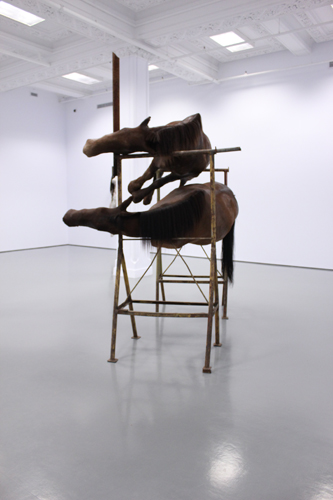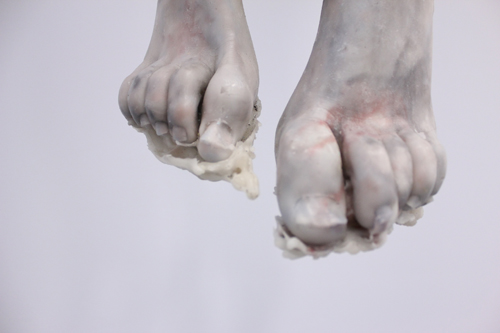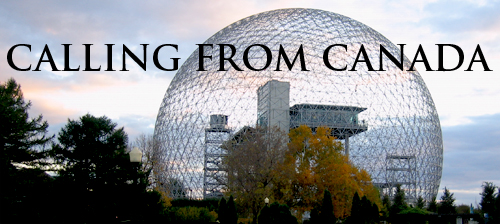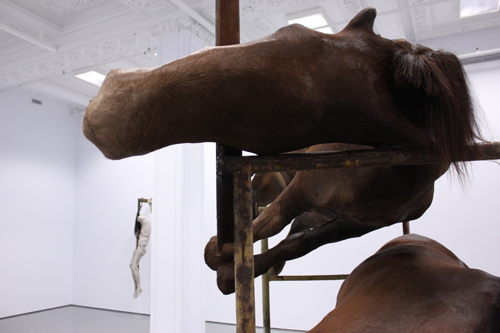Before the analysis comes rushing in like an insuppressible wave, I am struck with the straight-up “thingness” of Flemish artist, Berlinde De Bruyckere’s corporeal sculptures at gallery DHC in Montreal. For inanimate objects, the amorphous shapes, translucent white/gray/bluish depths and waxy textures on the one hand, and the immense brown-haired animals displayed on the other, these sculptures are a loud and demanding imposition when presented in a pristine, white cube. The materiality and scale are compelling enough on their own. The sculptures’ meticulously-crafted content and masterful aesthetic qualities are a visual mystery while their possible meanings stretch the interest of De Bruyckere’s work far beyond the physicality of the sculptures.

Berlinde de Bruyckere, "Les Deux," 2001 (partial installation view). DHC Gallery. Photo: Raji Sohal.

Berlinde de Bruyckere, "Les Deux," 2001 (partial installation view). DHC Gallery. Photo: Raji Sohal.
One of two rooms in De Bruyckere’s exhibition consists of casts of real humans created site-specifically for DHC – Invisible Beauty and Invisible Love (2011). In these works, boneless and headless bodies hang vulnerably from pole-like structures fixed off the ground, to the walls. They are as arrestingly beautiful in their carefully-rendered technique and form as they are disturbingly deformed and mutilated in their meaning. There is also a trestle holding two actual-size brown-haired horse figures in a piece entitled Les Deux, (2001), in which the creatures are stacked horizontally atop one another inside a precarious scaffolding structure. Their cultural symbolism suggest extreme weight and heaviness, but of course they are actually comprised of lightweight materials. Despite their stiff and vulnerable positioning, the horses appear vibrant and life-like, still powerful with the potential of wild horses in wait. To see a horse – a symbol of strength and war – in a position of defeat, loss, and compromise, points also to the fiction of the steadfast, heroic narrative. Soldiers fall, horses too. And war is very much about death and suffering of actual bodies. The two horses’ majesty is interrupted by the disturbing trestles in which they lie on exhibit, but also by their lack of facial features and the absence of their eyes – a gateway into identifying with the animals which we commonly associate with humans. The human body sculptures on the other hand, cling inwardly, the centre of their sinewy bodies are wrapped in a way around pole-like structures, seemingly resisting the world outside them. The physical agency is introverted, like someone who has failed or fallen, and its body center – its heart – hides from spectators; this is shame personifed. The bodies are without heads and without eyes, and so spectators can look, gawk, and gaze without being seen. The scrutiny extends beyond the material instantaneously, lending itself to parallel the political realm.

Berlinde de Bruyckere, "Invisible Beauty and "Invisible Love," 2011 (partial installation view). DHC Gallery. Photo: Raji Sohal.

Berlinde de Bruyckere, "Invisible Beauty and Invisible Love," 2011 (partial installation view). DHC Gallery. Photo: Raji Sohal.
Are these semi-crucified bodies – their mangled poses, and contorted configurations – a meditation on religion, war, news media photography, or art history? Do their hunger, pain, and suffering suggest a moral plot? Or, do they provide commentary on specific events of our recent history; prisoners of Guantanamo Bay, Rwandan genocide victims, or war detainees? The sculptures conjure up war journalism photographs no doubt; fragments of torture scenes we shouldn’t see but can’t take our eyes away from either. But news discourse is a privileged and authoritative version of reality, and contemporary art holds less influential cultural capital and popular circulation than breaking, bleeding news images. No, De Bruyckere’s sculptures do more than cite a specific historic event. And though the artist is cognizant of art history, her works do not necessarily offer an inventory of the history of art, either. Though the sculptures on display at DHC are of individual bodies, they suggest something more than the particular: they reveal that suffering is about the world and time travel. The sculptures conjure a sense that “we’ve always done this to one another.”

Berlinde de Bruyckere, "Invisible Beauty and Invisible Love," 2011 (detail, from partial installation view). DHC Gallery. Photo: Raji Sohal.
Actual bodies – the corporeal outlines (of blood, skin, and vital organs) that delineate an individual are made more common in situations of pain and suffering. The suffering body is quickly othered. Even if one attempts to empathize with the pain of another, the actual physical pain is not transferred. It remains in tact in the body of the sufferer. Anyone who has suffered physical pain knows that the body is as real as it gets, and no Deleuzian philosophizing about intensities and theoretical potentialities of existence can relieve the truth of the aging body; its prone and reactive flesh and skin are what every body has in common. The minimal presentation of De Bruyckere’s body sculptures at DHC seems to highlight this point, plainly displaying through coroporeality, that individuality is a myth and the individual/collective divide does not hold. Here, the collective is embodied, as the separate bodies remind that even one’s relation to oneself is about collectivity, about what a society is capable of doing to a single body. This sense of collective embodiment exemplified in the mangled and tortured body raises the notion that the political (not just politics, or ideology, but physical politics) and consciousness are the same thing. The bodies do not suggest a redeeming and isolated incident but a certain commonality among them, that pain becomes them. Although we are accustomed to believing in a Cartesian binary between thought and action, De Bruyckere’s visually and psychologically impacting sculptures show that in considering embodiment, there can be no stark difference between thought and action. They happen at the same time.
It may be out of fashion to suggest the theme of universality, but De Bruyckere’s artistic metaphor seems to contextualize and relativize human condition in such a way that inadvertently invokes a new set of coordinates with which to consider specific historic and current events. These life-sized bodies are removed from context and provided a new frame with which to not only look at them but to move around them. De Bruyckere does this work (though perhaps inadvertantly), through reconsidering the capitalist space – not through flipping newspages or news image screens on an iPad – but through staging the metaphor in a social and absolute space: the gallery. In this case, DHC is a privately-funded, open-to-the-public, free-admission gallery, and truly one of the most transparently inclusive art exhibition spaces devoted to contemporary art in Montreal. For Lefebvre, you can’t think about space prior to language: actual space is the act of production of knowledge, and sculpture may be the most savvy of the arts to this fact. Berlinde De Bruyckere’s works are often created site-specifically, and they ask spectators to, in a way, navigate around versions of ourselves and our society, and to literally walk amongst, gaze at, witness, and examine in a sense what it is we collectively do to one another.





